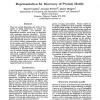284 search results - page 26 / 57 » Searching on the Secondary Structure of Protein Sequences |
ISMB
1993
13 years 8 months ago
1993
There are several dimensions and levels of complexity in which information on protein motifs may be available. For example, onedimensional sequence motifs may be associated with s...
EVOW
2004
Springer
13 years 11 months ago
2004
Springer
A number of bioinformatics tools use regular expression (RE) matching to locate protein or DNA sequence motifs that have been discovered by researchers in the laboratory. For exam...
RECOMB
2006
Springer
14 years 7 months ago
2006
Springer
In this paper, we present CONTRAlign, an extensible and fully automatic framework for parameter learning and protein pairwise sequence alignment using pair conditional random field...
BMCBI
2010
13 years 7 months ago
2010
Background: Large datasets of protein interactions provide a rich resource for the discovery of Short Linear Motifs (SLiMs) that recur in unrelated proteins. However, existing met...
BMCBI
2008
13 years 7 months ago
2008
Background: For many types of analyses, data about gene structure and locations of non-coding regions of genes are required. Although a vast amount of genomic sequence data is ava...


